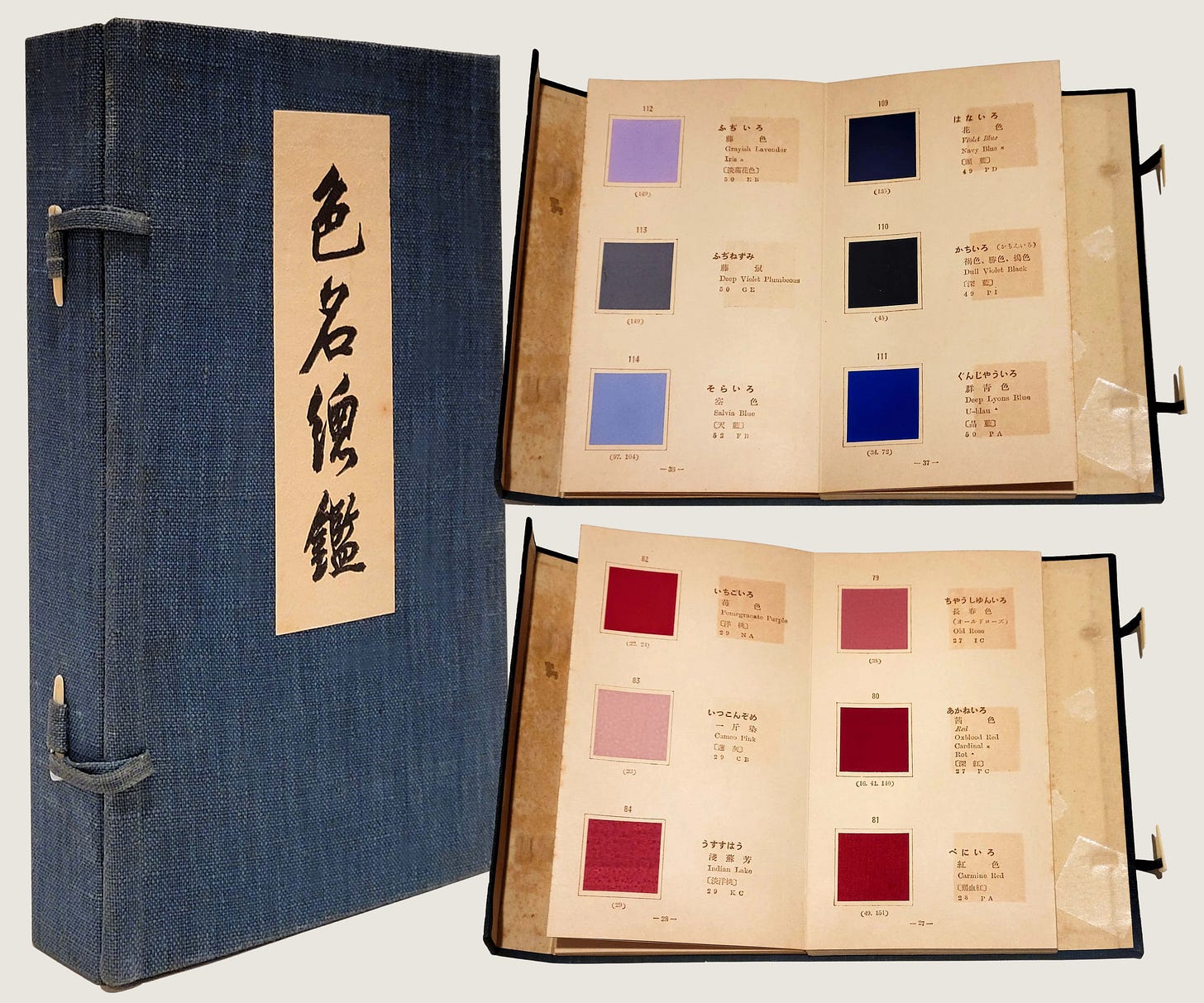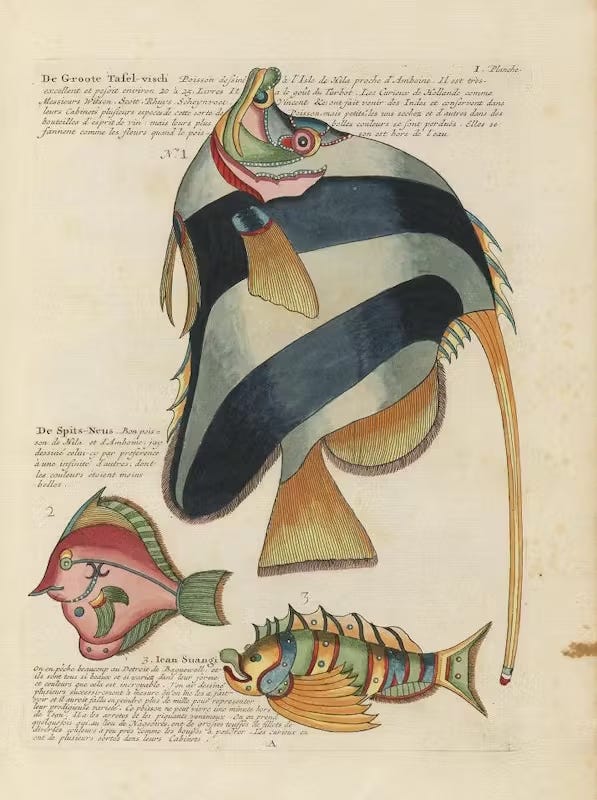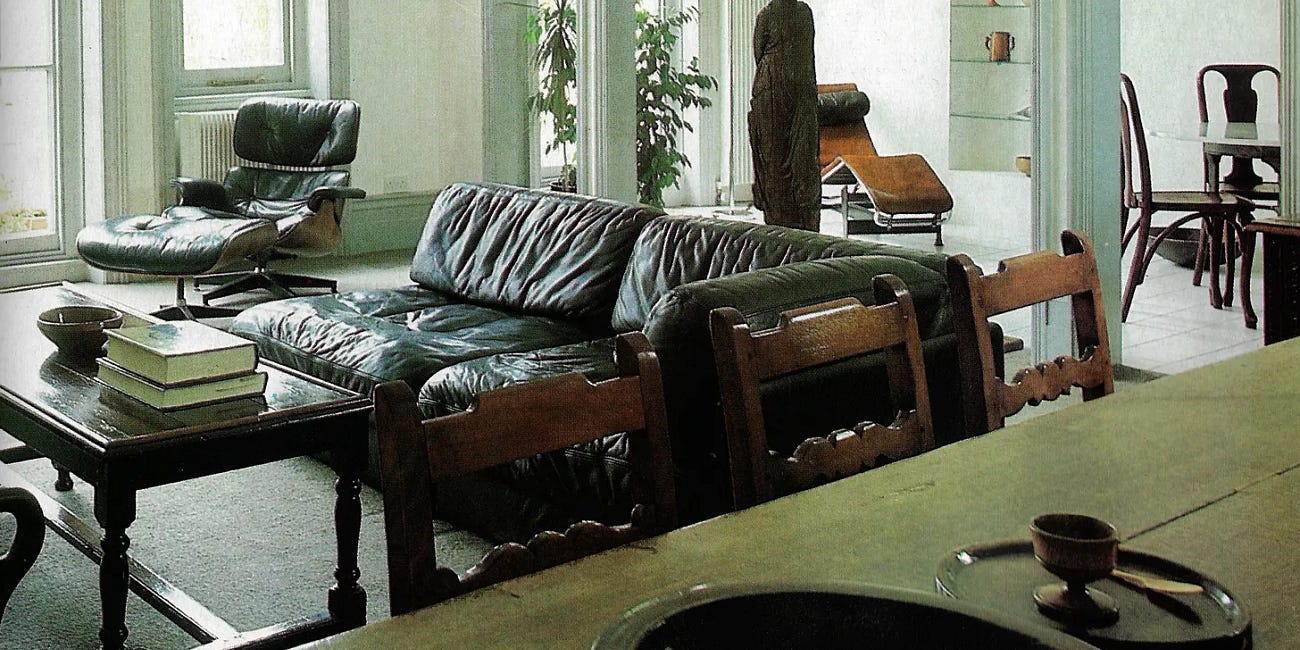Eleven Personal and Actually Helpful Tools For Creativity in a World That Demands Constant Content
Confessions of a Creative Founder. The Pressure to Perform and what I do when I have nothing to say
Today I'm opening up my creative toolbox. Sharing the practices and resources I turn to when I'm feeling stuck or uninspired. Before I get into that, I want to talk about a morning earlier this week that brought all of it into focus. A reminder of what it really feels like to run a creative-led brand in a world that expects constant output.
I woke up on Monday with a tightening in my chest. Not the sharp kind that makes you panic, but the slow, sticky kind that feels suspiciously like dread. Bright sunlight was streaming across the floor in those perfect golden beams. I eyed it with resentment and buried my head under the pillows.
I'd blocked off a few hours to write for A Whimsical World. I keep a running list of topics, and next up was a piece about the design and intention behind my garden. I've made gardening my entire summer personality; it's my favorite activity, and I'll talk incessantly about it to anyone who even feigns interest. But the thought of writing about it? It felt heavy. A deep resistance was welling up.
The garden is one of the few places in my life that hasn't been turned into content. I rarely bring my phone with me. It's a space for dirt-under-your-fingernails grounding. For getting lost in the slow process of learning how different plants thrive. Sometimes I rope in friends or family to weed alongside me, and it becomes a place for connection. The idea of stepping into that space with a camera, trying to frame it into "content," felt kind of like a violation.
Once that thought crept in, the spiral began. I started to resent the post. Then the platform. Then, if I'm being honest, the whole machine of content creation that I've willingly (and proudly) signed up for.
It's a mood I fall into sometimes. On a different morning, I might have been lit up by the exact same idea, the words tumbling out of me with no resistance.
And here's the reality: If you're a founder, especially of a creative brand, your job isn't just to lead. It's also to perform. And somewhere near the top of our unspoken job description, you'll find: content engine.
It's not enough to be creative anymore. You also have to prove it, every day, in public. You have to turn your inspiration into a swipeable carousel, your process into a behind-the-scenes reel, and your brand into a moodboard that updates in real time. Founders, especially in this hyper-visual, hyper-personal era, are expected to do the whole song and dance: to create, perform, market, narrate, and repeat.
Don't get me wrong—I love what I do. I'm energized by the storytelling, the visuals, and the dialogue with other creatives. I have worked hard to create a content strategy that I am excited about. One that feels realistic, that honors my need for privacy while meeting the demands of being a creative founder who "shows up."
But still, every now and then, I wake up with this thick feeling in my chest, like: I have nothing to say today. And I don't want to pretend I do.
Luckily, I have tools for this type of morning. A set of practices and resources that immediately pull me out of the fog and reconnect me to the joy of creating.
So today, instead of a garden story (which I know will bloom when it's ready), I'm sharing that toolbox with you:
Note to my readers: This post will be available to all readers for one week before moving behind the paywall. Paid subscribers always get full access to my creative toolbox + founder insights. If you find this piece valuable, consider subscribing to support more writing like this.
Morning Pages:
This is often the only tool I need. It's the one that gets things moving. Morning Pages is a practice from Julia Cameron's The Artist's Way: three pages of longhand, stream-of-consciousness writing, ideally done first thing in the morning (although I do them whenever I am feeling stuck). They are not meant to be art or even "writing" in the traditional sense, but a practice to clear mental clutter and connect with your creative self. And guys, they WORK. In Cameron's words, Morning Pages "provoke, clarify, comfort, cajole, prioritize, and synchronize the day at hand." I've found that to be true again and again. Just grab a notebook, a pen, and start writing. Anything. Everything. Your fears, your dreams, your weird to-do list. Your boredom. Your resentment. Follow your thoughts and don't edit a word. When people ask Cameron, "Why do Morning Pages?" her answer is simple and perfect: "To get to the other side."
An Inspiration Table:
I keep a table filled with things that spark inspiration. It can be any surface, really—a desk, a corner table, a coffee table. I pile it with art and design books, printed essays, books on my TBR, LES prototypes, early sketches, packaging I've loved, a beautiful piece of flatware, vintage jewelry that has just arrived. Anything that delights me in the moment. I just stack it all up and let it sit, and when I'm stuck or just need a break, I turn to the table. I flip through a book. I pick something up and ask myself: What is it I love about this? A curve, a color, a detail, a texture. It's a space I return to when I want to follow threads, see connections, and feel curious again.

Books and essays:
This one feels obvious, but it belongs on the list. Sometimes the most direct path to inspiration is detouring into someone else's world. When I'm feeling stuck, I reach for a book. It might be science fiction, an essay on technology, or a decades-old design book that hasn't made its way onto Pinterest yet. The kind where everything feels fresh again. Reading pulls me out of my own head. It quiets the internal noise and lets me borrow someone else's lens for a while. And in that shift out of my own narrative, away from the pressure to produce, something starts to move again.
People/Conversations:
Never underestimate the power of talking to other people. IRL conversations. Sometimes it's a member of my team I'm bouncing a creative idea off of. Sometimes it's my husband who brings up a topic I would never have thought to explore. Sometimes, it's my trainer at the gym who, weirdly, loves discussing existential philosophy between sets. The point is: ask questions. Get curious. Really listen. Try to be in the moment, without an agenda. Later, I'll return to the conversation and start to parse it. What were they actually saying? Why did that part stick with me? What thought is worth following? Like reading, this is a way to get outside your own mental loop and into someone else’s point of view.
Doodling or Watercolor
This one is all about creating just for the joy of it. No end goal. No pressure. Just line, color, play. Sometimes I doodle. Sometimes I pull out the watercolors. It's supposed to be lighthearted, childlike. In fact, I often do this alongside my kids. We sit at the table with paper and paint and just...make stuff. It's one of the fastest ways I know to shift back into a creative mindset, because it's not about getting it right. It's about remembering that creativity is fun. One of my favorite prompts is Carly Kuhn's "a word and a thing" exercise. It never fails to get my creativity back on track.
The Act of Noticing:
This one's technically a writing tool, but I find it useful for almost any kind of creative work. And it's simple (sort of). Just pay really close attention to something (anything). Look out the window and describe precisely what you see. The shade of the sky. The shape of the clouds. The way the light is hitting the side of a building. The exact color of someone's jacket as they pass by. Get specific—almost obsessively so. Then zoom out. How does it make you feel? What does it remind you of? What memory does it tug on? What mood does it evoke? Noticing is about being present, but also about collecting layers. It's how you start to see the world not just as it is, but as raw material. And the more you practice, the more you begin to find inspiration hiding in the most ordinary corners.
Are.na
I've written about this platform before, but I still had to include it on this list. To quote from Cool Things Vol I (should I do a volume II?): “Are.na is like Pinterest for the curious mind—a beautifully simple tool for creative exploration. It lets you collect and organize texts, PDFs, and website links into "channels" (think folders, but more intentional). The interface is refreshingly minimal, letting your ideas take center stage.” I initially used this tool to organize my research, but I've recently started exploring other channels. The inspiration is endless and has a totally different flavor from any other "social media" platform.
Color Theory:
This one's more specific, and I turn to it primarily when I am stuck on ideas for shoots or planned digital content. I start with color, and specifically the combinations. I have a set of books I like for this: part of a six-volume series called Haishoku Soukan by Sanzo Wada. Back when Japanese culture was absorbing influences from the West, Wada recognized how important color was becoming and laid the groundwork for what's now considered essential color theory. I have 2 books in the series that focus on color combinations (A Dictionary of Color Combinations, Vol II). It's like analog color play for the visually overstimulated. I'll flip through and think about how different colors interact, what feelings they evoke, and how they might guide the tone of a collection or a story. It helps me get unstuck by shifting my focus away from what I'm trying to say and toward how it might feel.

Artist Dates
This is another tool from Julia Cameron's The Artist's Way. An Artist Date is simple: you take yourself on a solo outing to do something creatively inspiring. It can be anything—a walk along the beach to collect shells, an hour spent wandering a museum, time to browse an antique mall with no agenda. The key is that you do it alone and that you give yourself the space to follow your curiosity without distraction. For me, the alone part is key. It gives me space to think, to pay attention to my own reactions, to get lost in some creative corner of the world without needing to explain why. As Cameron puts it, "Artist Dates fire up the imagination. They spark whimsy. They encourage play." And sometimes, they're exactly what I need to come back to my work with fresh eyes and a full tank.
Public Domain Image Archive
This one always feels like falling down a beautifully strange rabbit hole.
The Public Domain Image Archive is exactly what it sounds like—a treasure trove of open-access images pulled from museum collections, academic archives, and libraries. But what makes it special is its curation. It leans into the stranger side of art history: odd sculptures, forgotten manuscripts, early photography, unexpected juxtapositions. A lot of the images are old. Really old. Which makes them feel fresh again, especially in a visual landscape that's so trend-driven. I love following the bread crumbs. One image leads to another, and suddenly I'm five layers deep in some obscure corner of the 15th century... and completely inspired. It is where I have discovered things like the Erbario Manuscripts that have stayed with me for years.

Ebay/Etsy/1st Dibs/Chairish/Live Auctioneers
When I need a scroll, but don't want to end up in an Instagram spiral, I turn to vintage and antique platforms instead. I search different categories, check in on my favorite sellers, and follow recommendations from past purchases or saved items. It's sort of like rummaging through a beautifully cluttered attic where everything might spark an idea. Unlike social media, which often leaves me feeling depleted, this kind of browsing leaves me energized. I come away with ideas for materials, shapes, palettes, and even stories. It's visual inspiration with substance. Design history, craftsmanship, and cultural references are all layered in.
That's the toolbox. Not a formula, just a set of practices I return to when the creative spark feels dim or the pressure to perform starts to take over. Some days, all I need is one. Other days, I cycle through three or four before something clicks. But they always bring me back to myself and to the joy of creation.
If you have your own version of this list, I'd love to hear it. And if not, maybe this is your invitation to start one.
And now in LES news…
We just launched our limited edition summer scent: Siren’s Garden. It’s our love letter to the lush abundance of the season. A romantic blend of coconut, cedar, vetiver, and amyris that calls to mind overgrown garden paths, sun-warmed skin, and the soft hush of waves just beyond the hedges.
This scent is always burning at my lake house. It instantly reminds me of the slow, golden days of summer. I can’t get enough of it.
The vessel, shaped like a summer rose, was crafted by Sasha Court and meant to be treasured long after the final flicker. And yes, I breached the sanctuary of my vegetable garden to shoot it. It simply belonged there, nestled in all that wild, natural beauty (an example of content that just felt right).
That’s all for today. Thank you for reading! Consider becoming a paid subscriber for access to more personal stories (especially around founder life, creative burnout, and strategy) and my deep dive sourcing and styling guides. Your support truly makes this possible.
If you liked this, please share it with a friend and leave a comment! For more creativity, you can follow us on IG and explore years of art and design articles on the LES Journal
Keep Reading…
If Your Brand Still Uses the Word ‘Timeless,’ Read This
I recently came across an essay in FOR SCALE’s print magazine that boldly declared the word “timeless in design as meaningless nonsense, written by lazy marketers disconnected from the true nature of taste. It begins:
What Alessi's Tea And Coffee Piazzas Can Teach Us About Narrative Design
Human hands, cast in silver, reach from nowhere—fingers curling around a perfectly polished rectangular tray. Perched atop: a curious family of objects, seemingly in conversation. Each piece has its own fantastical personality. Their sleek surfaces contrast with richly detailed ornamentation—a round lidded bowl with ears, strands of hair braided into ha…














I very much enjoyed this post and your suggestions. I consider myself rather intellectually creative but dismally lacking on the aesthetic side. Thanks for cracking that door open a bit more (again).
Are.na sounds very helpful! This is my 2nd attempt at a Substack primarily because I have no engagement whatsoever with my instagram or website. I figured at least here I’d find like-minded people. You do a great job with your content and I have been following along for some time now.
I found the Internet Archive a wellspring of inspo my first try, esp navigating through old shelter magazines. On those days when you’re looking through the public domain!!